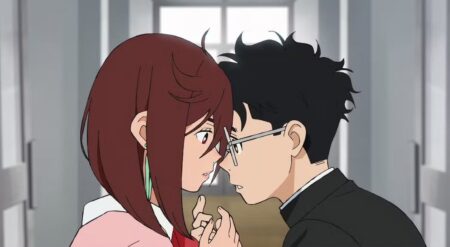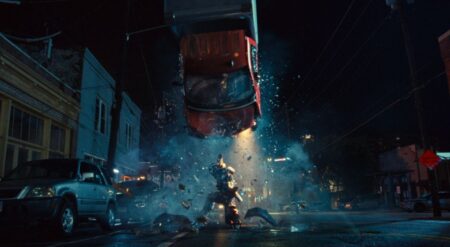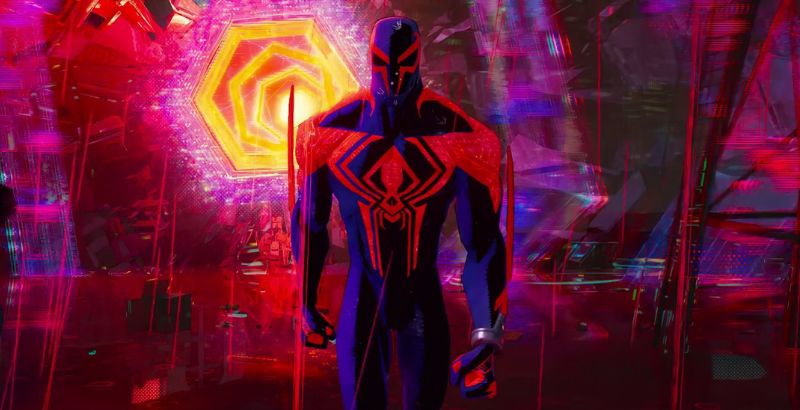
In Spider-Man: Into the Spider-Verse, we see universes collide and meet some of the faces behind the Spider-Man mask that aren’t Peter Parker. In the film, we follow Miles Morales through his origin story and we meet characters like Spider-Gwen and Peni Parker along the way. While the film does a great job of giving us an introduction to Spiders some haven’t read about before, it’s the Spidey in the post-credit scene with Miguel O’Hara that we know the least amount of information about. And it’s this Spider-Man that can be the tentpole for a sustained Spider-Verse franchise. And now with Spider-Man 2099 taking a new lead role in Spider-Man: Across the Spider-Verse, it’s definitely time to brush up on who Miguel is. As we head into the sequel, there is a lot to more.
If you stayed until after the credits at the end of Into the Spider-Verse, you met the friendly neighborhood Spider-Man from Nueva York in the year 2099. In the scene, we hear a woman talking about the travel between multiple universes – something that is kind of hinted at with Gwen Stacy (aka Spider-Gwen) and Miles’ flirtations at the end of the film – and each monitor has a different Spider that we met throughout the film. It’s clear that she’s talking to the first confirmed person who jumped through the Spider-Verse at will. As the shot moves back, we see who it is. Voiced by Oscar Isaac, we see Miguel O’Hara, also known as Spider-Man 2099. Having been given a special watch to jump between universe, he is asked to assemble as many Spiders as possible for a mission.
For me, the moment I saw “Meanwhile in Nueva York…” pop up on the screen I knew who was coming and it took everything in me not to jump out of my seat. In the 2014 Marvel event, “Spider-Verse,” we see pieces of what is hinted at in this scene. Although the arc is generally not considered the best for the Spider-Man title due to the number of crossover issues of existing comics the reader had to buy, the story has become a mainstay in the current era of Spider-Man.
Spider-Man 2099 has not only been used for Into the Spider-Verse but also in the Disney XD series Ultimate Spider-Man, the latter of which Miguel O’Hara plays a large part in. In the comics and the recent series, Spider-Man 2099 is an important bookend and player in the team of Spiders. Assuming SONY Animation is going down the road of a sustained Spider-Verse franchise, if you didn’t know Miguel before, now is the time to learn. So, here are the basics to help you get to know Spider-Man 2099.
Origin Story
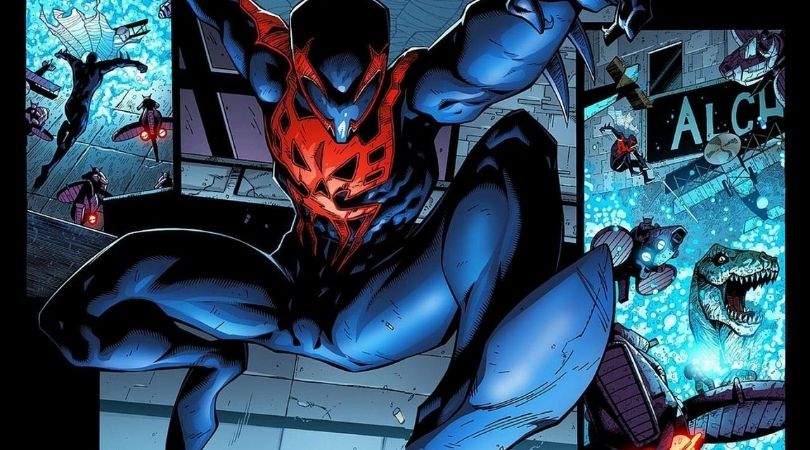
Created by Peter David and Rick Leonardi, Spider-Man 2099 first appeared in The Amazing Spider-Man #365 in 1992 and later that year started his own series in Spider-Man 2099 #1. Like the title suggests, the book takes place in the year 2099 A.D. within an alternate and dystopian future of New York. Miguel O’Hara’s addition to the Spider-Verse was prompted by the establishment of the Marvel 2099 imprint in 1992 which showed one possible future for the Marvel Universes, he was one four titles that established the series.
Miguel O’Hara is a geneticist trying to recreate the abilities of the first Spider-Man. As head of Alchemax, the nefarious corporation featured in Into the Spider-Verse, he was tasked with these experiments to create a new type of super-soldier. Now, this all sounds like the origins for a villain, but when a human trial subject dies, Miguel resigns.
However, he can’t just take off. Not being able to let their lead scientist go, Miguel is drugged with an Alchemax proprietary and addictive drug called Rapture. With the threat of jail, if he leaves the corporation, he attempts to rewrite the part of his genetic code that has bonded with the drug. But when things don’t go as planned and the machine is sabotaged by a lab assistant. As a result his DNA is rewritten, effectively making half-Spider.
Miguel O’Hara is of both Irish and Mexican descent, making him the first Latinx character to take up a Spider mantle — followed by Anya Corazon (Spider-Girl FKA Arana) and Miles Morales. As a hero, Miguel transforms from only searching for a cure to realizing that he has to change. He begins to realize the role he played in the damage that corporations have done to the city and he begins to realize how much his existence as Spider-Man has an impact on the oppressed people of the city. After this journey and seeing his mother, who despises what he became at Alchemax, admire Spider-Man, he takes up the identity and makes it his goal to fight against the corporations controlling the city.
After the series wrapped in 1998, the comic was relaunched in 2014, with the first issue selling over 100,000 copies on its first printing. While Peter Parker was ruling television in the 1990s, Spider-Man 2099 was ruling comics, so much so that there was an animated series in the works. However, it was axed in favor of Spider-Man: Unlimited. That being said, that series used a costume very similar to Miguel’s suit and his futuristic setting but instead featured Peter Parker as the protagonist.
Miguel O’Hara: Powers
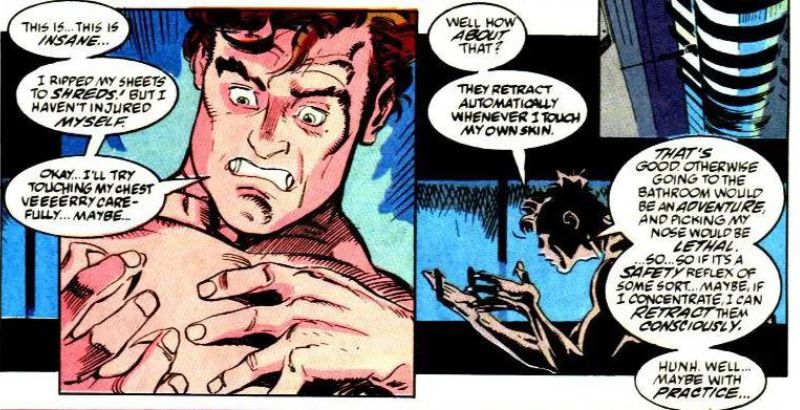
Just like Peter Parker, Miguel O’Hara has a genius-level IQ, super strength, dexterity, and agility. Now, while the Spider-Family is large, not every version of Spidey has the same powers. Miles, like Into the Spider-Verse showed, has camouflage powers that render him invisible and is able to shoot an electric charge from his body. Miguel also has differences to the original Spidey.
Thanks to his DNA being rewritten, Miguel has spinnerets in his forearms and can control the thickness of the webbing mentally. He also has claws on his hands and feet which will tear anything other than his suit to shreds, although they can fold down with concentration to help him get through everyday life. But unlike many of the other Spider-People, these talons serve as his only means of adhering to surfaces. In addition to that, he has increased vision and hearing, replacing Peter’s signature Spidey-sense. But, his increased vision has a drawback. Miguel is extremely sensitive to light meaning he can be blinded by normal light when not wearing tinted glasses or his mask – making his eyes become red – and overall easily knocked off-guard.
Perhaps the strangest piece of his power-set and the piece that solidifies his truly half-spider DNA is his venomous bite. That’s right. He’s bitten, people. The venom stored in his fangs will paralyze anyone bitten by him. However, like his talons, the elongated canine teeth are not retractable. A lot of Miguel’s life changed not only because of his heroics but because of the alterations to his appearance. Although, in recent iterations, they have become retractable talons.
Miguel O’Hara: The Suit
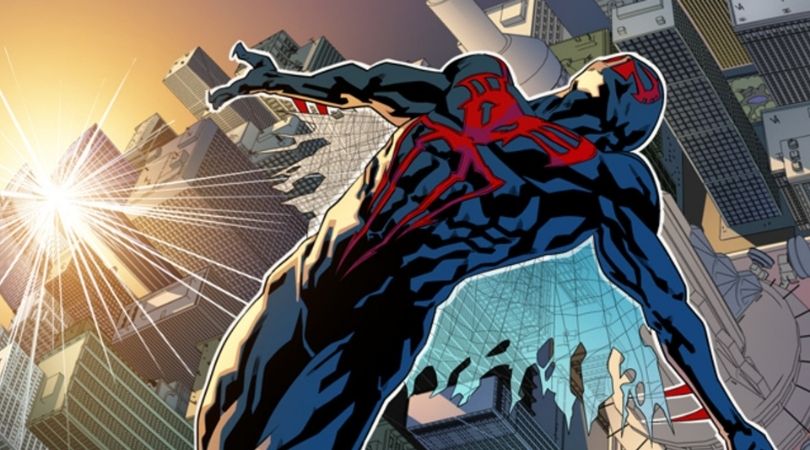
Spider-Man is defined by his suit. The run of a particular writer and illustrator combo, video game, and movies are each defined by their suits. This is no different for the Spider-Family. Because of his power set, Miguel O’Hara is forced to use an old suit he last wore for a Dia de Muertos celebration – the explanation for the skull in the center of his Spider-symbol. He chooses this suit is made from Unstable Molecule Fabric (UMF) and was invented by Reed Richards to be indestructible. It was designed to interact with super-powers without hampering them, an important factor for the first family of Marvel. Because it’s durability, Miguel is able to use his talons through both the gloves and boots, allowing him to grip walls while not cutting his suit.
One of the most distinguishable pieces of his suit is similar to the spider-wings of the original Amazing Spider-Man suit, webbed netting. Miguel has a cape of webbed airfoil attached to the back of his costume and is made out of a substance called “Lyte Byte” which was made to capture and direct air currents, allowing him to glide through Nueva York. The smartest piece of his design is something other web-slingers should take up: mask reinforcement.
It’s my favorite detail in his character design and shows that the things forward and doesn’t think that he’s invincible. While in his suit, Miguel reinforces his mask with webbing which will keep his mask from being removed in case he is captured. With the use of his talons, he is able to easily remove his costume while others can’t. Granted this couldn’t have yielded the iconic upside-down kiss.
Where else can you see him?
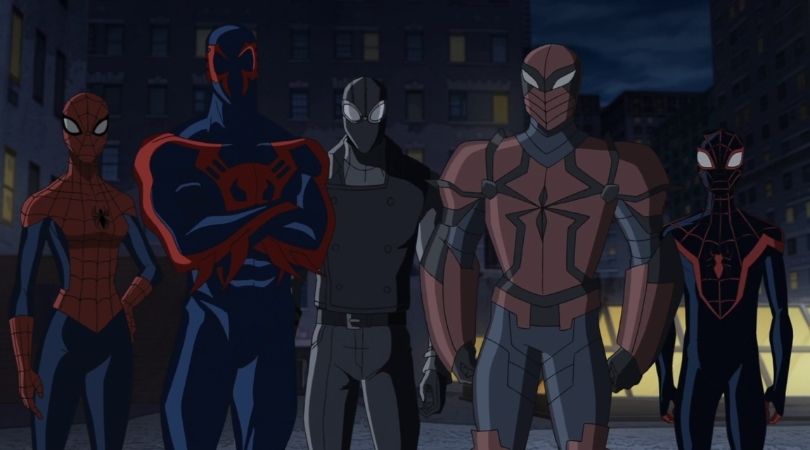
If you’re looking to get more familiar with Spider-Man 2099 I suggest you start by reading his second run from 2014 which has 12 issues available on Marvel Unlimited. Then read through the 33 issues of his 90s run also available on the platform. There is a lot of story and Miguel O’Hara is a great character whose evolution from an “evil” scientist villain trope at Alchemax to a man of the people is a must-read.
However, if comics aren’t your jam and you’re more into watching your heroes, start off your adventure with the four-part “Spider-Verse” episodes from season 3 of Disney XD’s Ultimate Spider-Man. You can also check out the rest of the Web Warriors. If video games are more your style, he was also one of the four versions of Spider-Man that was playable in Spider-Man: Shattered Dimensions that came out in 2010 for all consoles and PC — (PS3, Xbox 360 generation.) If you can snag a copy, I highly recommend it. And maybe some Doctor Doom action int he future?
Miguel O’Hara in Across the Spider-Verse
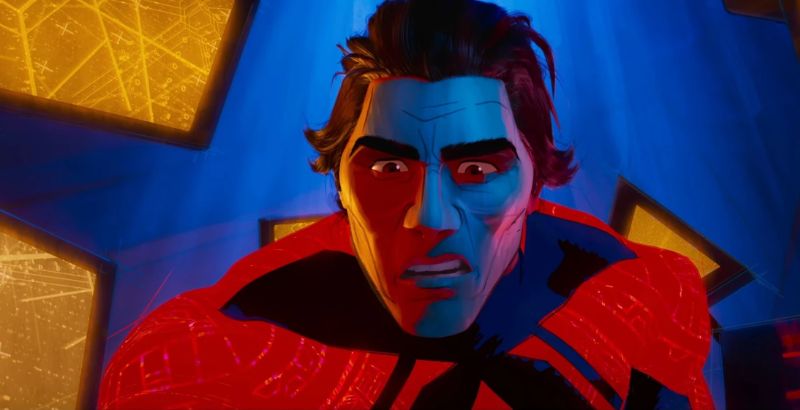
Now in Across the Spider-Verse, Miguel is taking a front seat as the leader of the Spider-Society where he leads a group of Spider-People to protect the world from anomalies. Keeping order to the Web of Destiny, Miguel has taken the role of leader and that means doing things you don’t like, and others might not like either. Protect the world at all cost and save the most people possible even if that means losing one. Directed by Joaquim Dos Santos, Kemp Powers, and Justin K. Thompson and written by Phil Lord & Christopher Miller and Dave Callaham the sequel film to Into the Spider-Verse uses Miguel to confront the very meaning of what makes someone into a Spider-Person.
Filled with grief about losing a family he thought he could have, Miguel jumps through the Spider-Verse in order to stop other Spider-People from making the same mistake: thinking they can have it all. While Miguel is an antagonist in Across the Spider-Verse he’s well-intentioned and trying to save the multiverse in the only way he knows how. That just puts him at odds with Miles who refuses to accept that the only way to save the world, he has to let one person die. Complex, Miguel O’Hara adds an element to the film that has to be watched.
Outside of the cultural importance of having not one but two Latino superheroes on the big screen in this animation, Miguel’s inclusion can stand as a promise of a sustained franchise from Sony Animation. While there hasn’t been confirmation on a franchise just yet, Miguel O’Hara’s inclusion has to be more than just an easter egg, although it is possible. In the comics, there is much more to explore in Spider-Verse Miguel O’hara and subsequent films are the perfect person to explore it.
Spider-Man: Across the Spider-Verse is in theaters June 2, 2023.


